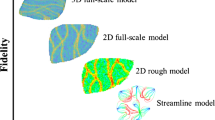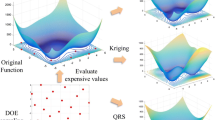Abstract
Multi-objective well control optimization, which considers simultaneous optimization of more than one objective, has become an essential tool for efficient intelligent decision-making about well control parameters. In general, multi-objective well control parameter optimization involves numerical simulation, which is computationally expensive. Surrogate-assisted methods that use a simple yet rigorous approximation model have shown great potential in reducing the need for expensive numerical simulations. In order to strike a balance between reducing computational burden and enhancing accuracy of a surrogate model, we introduce here a semi-supervised learning method called tri-training surrogate-assisted multi-objective optimization (MOO–TTSA), which is based on radial basis function network (RBFN) and non-dominated sorting genetic algorithm-II (NSGA-II) to assist the optimization process. The uniqueness of this method is that a tri-training strategy is applied to enrich the training data set by selecting solutions with high-confidence fitness to renew the surrogate model at each generation so as to obtain better accuracy and lessen the computational burden. In this way, the number of simulation runs is reduced while the accuracy of the surrogate is guaranteed. To the best of our knowledge, this is the first time that a combination of tri-training technique and MOO is used for reservoir well control problems. The MOO–TTSA method was applied to two benchmark problems and two synthetic reservoirs. The results showed that the MOO–TTSA method reduced the number of simulation runs on the two reservoirs, one for about 160 times and the other for 50 times. Besides, the hypervolumes of both the benchmark and reservoir problems of MOO–TTSA were similar with those of the simulation-based NSGA-II method (NSGA-II), but superior to those of the single static surrogate model-based NSGA-II method (RBFN–NSGA-II). It was shown that the MOO–TTSA method was more efficient, superior and converged faster compared to the other conventional optimization models.





















Similar content being viewed by others
References
Azamipour, V., Misaghian, N., & Assareh, M. (2020). Multi-level optimization of reservoir scheduling using multi-resolution wavelet-based up-scaled models. Natural Resources Research, 29(3), 2103–2125.
Bagherinezhad, A., Bozorgmehry, R. B., & Pishvaie, M. R. (2017). Multi-criterion based well placement and control in the water-flooding of naturally fractured reservoir. Journal of Petroleum Science and Engineering, 149, 675–685.
Blum, A., & Mitchell, T. (1998). Combining labeled and unlabeled data with co-training. Proceedings of the Eleventh Annual Conference on Computational Learning Theory. https://doi.org/10.1145/279943.279962
Chang, Y., Bouzarkouna, Z., & Devegowda, D. (2015). Multi-objective optimization for rapid and robust optimal oilfield development under geological uncertainty. Computational Geosciences, 19(4), 933–950.
Chen, Y., & Oliver, D. S. (2010). Ensemble-based closed-loop optimization applied to Brugge field. SPE Reservoir Evaluation & Engineering, 13(01), 56–71.
Chen, B., & Reynolds, A. C. (2016). Ensemble-based optimization of the water-alternating-gas-injection process. SPE Journal, 21(03), 0786–0798.
Chen, G., Zhang, K., Zhang, L., Xue, X., Ji, D., Yao, C., Yao, J., & Yang, Y. (2020). Global and local surrogate-model-assisted differential evolution for waterflooding production optimization. SPE Journal, 25(01), 105–118.
Coello, C.A.C., & Sierra, M.R, (2004). A study of the parallelization of a coevolutionary multi-objective evolutionary algorithm. In: Mexican international conference on artificial intelligence, pp. 688–697. https://doi.org/10.1007/978-3-540-24694-7_71
Deb, K., Pratap, A., Agarwal, S., & Meyarivan, T. A. M. T. (2002). A fast and elitist multiobjective genetic algorithm: NSGA-II. IEEE Transactions on Evolutionary Computation, 6(2), 182–197.
Ding, S., Jiang, H., Liu, G., Sun, L., Lu, X., & Zhao, L. (2016). Determining the levels and parameters of thief zone based on automatic history matching and fuzzy method. Journal of Petroleum Science and Engineering, 138, 138–152.
Fonseca, R. M., Reynolds, A. C., & Jansen, J. D. (2016). Generation of a Pareto front for a bi-objective water flooding optimization problem using approximate ensemble gradients. Journal of Petroleum Science and Engineering, 147, 249–260.
Guo, Z., & Reynolds, A. C. (2018). Robust life-cycle production optimization with a support-vector-regression proxy. SPE Journal, 23(06), 2409–2427.
Guo, Z., Chen, C., Gao, G., & Vink, J. (2018). Enhancing the performance of the distributed Gauss–Newton optimization method by reducing the effect of numerical noise and truncation error with support-vector regression. SPE Journal, 23(06), 2428–2443.
Hanssen, K. G., Codas, A., & Foss, B. (2017). Closed-loop predictions in reservoir management under uncertainty. SPE Journal, 22(05), 1585–1595.
Hojjati, A., Monadi, M., Faridhosseini, A., & Mohammadi, M. (2018). Application and comparison of NSGA-II and MOPSO in multi-objective optimization of water resources systems. Journal of Hydrology and Hydromechanics, 66(3), 323–329.
Huband, S., Hingston, P., While, L., & Barone, L. (2003). An evolution strategy with probabilistic mutation for multi-objective optimisation. In: The 2003 congress on evolutionary computation, 2284–2291. https://doi.org/10.1109/CEC.2003.1299373
Isebor, O. J., & Durlofsky, L. J. (2014). Biobjective optimization for general oil field development. Journal of Petroleum Science and Engineering, 119, 123–138.
Isebor, O. J., Durlofsky, L. J., & Ciaurri, D. E. (2014). A derivative-free methodology with local and global search for the constrained joint optimization of well locations and controls. Computational Geosciences, 18(3), 463–482.
Jansen, J. D., Durlofsky, L. J., Aziz, K., & van Kruijsdijk, C. P. J. W. (2006). Preface; closed loop reservoir management. Computational Geosciences, 10(1), 1–2.
Jansen, J. D., Fonseca, R. M., Kahrobaei, S., Siraj, M. M., Van Essen, G. M., & Van den Hof, P. M. J. (2014). The egg model—a geological ensemble for reservoir simulation. Geoscience Data Journal, 1(2), 192–195.
Joppen, R., von Enzberg, S., Kühn, I. A., & Dumitrescu, I. R. (2019). A practical framework for the optimization of production management processes. Procedia Manufacturing, 33, 406–413.
Lie, K. A. (2019). An introduction to reservoir simulation using MATLAB/GNU octave: user guide for the MATLAB reservoir simulation toolbox (MRST). Cambridge: Cambridge University Press. https://doi.org/10.1017/9781108591416
Liu, X., & Reynolds, A. C. (2016). Gradient-based multiobjective optimization for maximizing expectation and minimizing uncertainty or risk with application to optimal well-control problem with only bound constraints. SPE Journal, 21(05), 1813–1829.
Liu, X., & Reynolds, A. C. (2017). Robust gradient-based multiobjective optimization for the generation of well controls to maximize the net-present-value of production under geological uncertainty. Mathematical Geosciences, 49(3), 361–394.
Liu, Y., Sun, W., & Durlofsky, L. J. (2019). A deep-learning-based geological parameterization for history matching complex models. Mathematical Geosciences, 51(6), 725–766.
Lu, R., Forouzanfar, F., & Reynolds, A.C. (2017). Bi-objective optimization of well placement and controls using stosag. In: SPE reservoir simulation conference. https://doi.org/10.2118/182705-MS
Menad, N. A., & Noureddine, Z. (2019). An efficient methodology for multi-objective optimization of water alternating CO2 EOR process. Journal of the Taiwan Institute of Chemical Engineers, 99, 154–165.
Ng, C. S. W., Ghahfarokhi, A. J., Amar, M. N., & Torsæter, O. (2021). Smart proxy modeling of a fractured reservoir model for production optimization: Implementation of metaheuristic algorithm and probabilistic application. Natural Resources Research, 30(3), 2431–2462.
Nguyen, H., Bui, X. N., Choi, Y., Lee, C. W., & Armaghani, D. J. (2021). A novel combination of whale optimization algorithm and support vector machine with different kernel functions for prediction of blasting-induced fly-rock in quarry mines. Natural Resources Research, 30(1), 191–207.
Oliveira, D. F., & Reynolds, A. (2014). An adaptive hierarchical multiscale algorithm for estimation of optimal well controls. SPE Journal, 19(05), 909–930.
Park, H. Y., Datta-Gupta, A., & King, M. J. (2015). Handling conflicting multiple objectives using pareto-based evolutionary algorithm during history matching of reservoir performance. Journal of Petroleum Science and Engineering., 125, 48–66.
Rao, X., Zhao, H., & Deng, Q. (2020). Artificial-neural-network (ANN) based proxy model for performances forecast and inverse project design of water huff-n-puff technology. Journal of Petroleum Science and Engineering, 195, 107851.
Sarma, P., Chen, W. H., Durlofsky, L. J., & Aziz, K. (2008). Production optimization with adjoint models under nonlinear control-state path inequality constraints. SPE Reservoir Evaluation & Engineering, 11(02), 326–339.
Sun, S. (2013). A survey of multi-view machine learning. Neural Computing and Applications, 23(7), 2031–2038.
Sun, C., Jin, Y., Cheng, R., Ding, J., & Zeng, J. (2017). Surrogate-assisted cooperative swarm optimization of high-dimensional expensive problems. IEEE Transactions on Evolutionary Computation, 21(4), 644–660.
Van Essen, G. M., Van den Hof, P. M., & Jansen, J. D. (2009). Hierarchical economic optimization of oil production from petroleum reservoirs. IFAC Proceedings Volumes, 42(11), 738–743. https://doi.org/10.3182/20090712-4-TR-2008.00120
Wang, L., Li, Z., Adenutsi, C. D., Zhang, L., Lai, F., & Wang, K. (2020). A novel multi-objective optimization method for well control parameters based on PSO-LSSVR proxy model and NSGA-II algorithm. Journal of Petroleum Science and Engineering, 196, 107694.
Yu, H., Tan, Y., Zeng, J., Sun, C., & Jin, Y. (2018). Surrogate-assisted hierarchical particle swarm optimization. Information Sciences, 454, 59–72.
Zhang, K., Zhang, L. M., Yao, J., Chen, Y. X., & Lu, R. R. (2014). Water flooding optimization with adjoint model under control constraints. Journal of Hydrodynamics Series B, 26(1), 75–85.
Zhang, H., Zhang, K., Zhang, L., Sheng, J., Yao, J., Wang, J., & Yang, Y. (2019a). Construction and optimization of adaptive well pattern based on reservoir anisotropy and uncertainty. Journal of Petroleum Science and Engineering, 181, 106252.
Zhang, L., Li, Z., Lai, F., Li, H., Adenutsi, C. D., Wang, K., Yang, S., & Xu, W. (2019b). Integrated optimization design for horizontal well placement and fracturing in tight oil reservoirs. Journal of Petroleum Science and Engineering, 178, 82–96.
Zhang, L., Xu, C., Zhang, K., Yao, C., Yang, Y., & Yao, J. (2020a). Production optimization for alternated separate-layer water injection in complex fault reservoirs. Journal of Petroleum Science and Engineering, 193, 107409.
Zhang, L., Li, Z., Li, H., Adenutsi, C. D., Lai, F., Wang, K., & Yang, S. (2020b). Application of polynomial chaos expansion to optimize injection-production parameters under uncertainty. Mathematical Problems in Engineering, 2020, 5374523.
Zhao, M., Zhang, K., Chen, G., Zhao, X., Yao, C., Sun, H., Huang, Z., & Yao, J. (2020a). A surrogate-assisted multi-objective evolutionary algorithm with dimension-reduction for production optimization. Journal of Petroleum Science and Engineering, 192, 107192.
Zhao, M., Zhang, K., Chen, G., Zhao, X., Yao, J., Yao, C., Zhang, L., & Yang, Y. (2020b). A classification-based surrogate-assisted multiobjective evolutionary algorithm for production optimization under geological uncertainty. SPE Journal, 25(05), 2450–2469.
Zhou, Z., Ong, Y. S., Nguyen, M. H., & Lim, D. (2005). A study on polynomial regression and Gaussian process global surrogate model in hierarchical surrogate-assisted evolutionary algorithm. In: 2005 IEEE congress on evolutionary computation, 2832–2839. https://doi.org/10.1109/CEC.2005.1555050
Zhou, Z. H., & Li, M. (2005). Tri-training: Exploiting unlabeled data using three classifiers. IEEE Transactions on Knowledge and Data Engineering, 17(11), 1529–1541.
Zhu, Y., & Zabaras, N. (2018). Bayesian deep convolutional encoder–decoder networks for surrogate modeling and uncertainty quantification. Journal of Computational Physics, 366, 415–444.
Acknowledgments
The authors would like to acknowledge financial support from the National Basic Research Program of China (2015CB250900) and the reservoir numerical simulation software provided by MRST.
Author information
Authors and Affiliations
Corresponding authors
Rights and permissions
About this article
Cite this article
Wang, L., Yao, Y., Wang, K. et al. A Novel Surrogate-Assisted Multi-objective Optimization Method for Well Control Parameters Based on Tri-Training. Nat Resour Res 30, 4825–4841 (2021). https://doi.org/10.1007/s11053-021-09948-9
Received:
Accepted:
Published:
Issue Date:
DOI: https://doi.org/10.1007/s11053-021-09948-9




